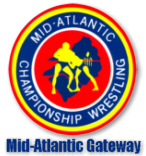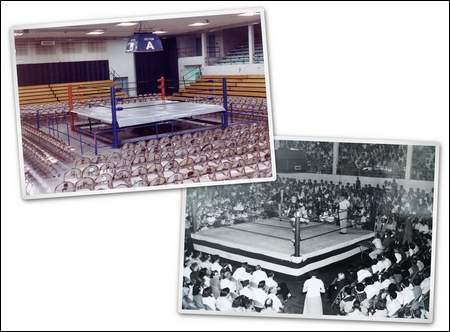
|
Not Down For The Count |
|
|
SPARTANBURG MEMORIAL AUDITORIUM INDEX RETURN TO THE MID-ATLANTIC GATEWAY
|
JASON GILMER, Staff Writer Article published Jul 23, 2006
It rests just feet from where it once hung and is still adorned with an A, B, C or D on each side that showed wrestling patrons in which section their tickets would place them. For years, the light hung above the venue's ring, feet from the action. Andre The Giant, all 7-foot-4 of him and even taller with his arms extended, almost lifted an opponent into the light in one of his two appearances in town during the mid 1970s. Memories of professional wrestling in Spartanburg, where it was a fixture for a generation, can be seen in the light shade. The color is a bit faded, but the passion hasn't flamed out.
"It kept us going," Steve Jones, general manager of the Spartanburg Memorial Auditorium, said. "It helped us pay our power bill. It was a sure thing. Every week there was wrestling. You didn't have to worry, 'Do we have a concert this week?' " The biggest company in the sport, World Wrestling Entertainment (formerly World Wrestling Federation) uses swear words, chair shots, backstage ambushes and over-the-top interviews to sell one of its superstars as a bad guy. Ivan Koloff simply needed to pull his opponent's hair, tug his trunks or use a closed fist against the referee's instructions to get heat. And then fans would let him have it, with screams, boos and flying objects. "The acoustics were great to get the atmosphere and get a reaction from fans for matches," Koloff, 63, said recently from his home in Greenville, N.C. "I can remember it being an ideal place for a match. …There's no bad remembrances -- just good memories." Between rummage sales, circuses, high school basketball, gun shows, guitar shows, Ice Capades, banquets and dressing rooms for beauty pageants, the low-ceiling basement housed wrestling shows that captivated families. Other activities didn't entice an audience like wrestling. Those events would bring a crowd to the cramped space in droves. On some nights, if the matches had star power, a fire marshal would stand at the doorway and hold a clicker to count the number of fans who entered. Once it reached capacity, he'd stop people at the door. Now, WWE will come into a town once or twice a year, sell out a 16,000-capacity auditorium with main event after main event and call it a successful night. Wahoo McDaniel, Ric Flair and the Masked Superstar would sell out the 2,000-seat Spartanburg Memorial Auditorium every Saturday night and call it normal. "I used to love to look on our (traveling) sheet, and see Spartanburg. You knew you'd make some money," said George South, who still wrestles and has a wrestling school in Charlotte. Wrestling was wrestling back in the '80s, not sports entertainment. Performers were taught the basics and knew how to work an opponent without delivering a series of high-flying hot shots to win over a crowd. The Internet had yet to take off, so results for matches in cities across the Southeast were almost impossible to find. So, fans came back week after week to pick up on storylines that involved their favorite wrestlers. "That building had the atmosphere of the crowd. When you have a building that has 2,000 or 3,000 fans, I think it makes it more personal," Koloff said. A low ceiling is nearly impossible to witness during televised wrestling now. The sport has moved from regional success to international phenomenon. Wrestling can be viewed on prime-time television, seen on Web sites with streaming video and in a myriad of other locations. This wasn't the case back in the 1980s, when Mid-Atlantic Wrestling did television tapings each week from the auditorium. The ceiling increased the sound, wrestlers said, and it made the experience more enjoyable. "The Spartanburg coliseum wasn't a bad building at all," said eight-time NWA Heavyweight Champion Harley Race, 63. "The way it was set up, the seating was excellent. Every one had a great seat. As far as small arenas were, it was as good as any." "They sold it out week after week (in Spartanburg)," said Dick Bourne, who runs a Web site dedicated to Mid-Atlantic Wrestling. The site has a section of classic venues, and one is the Memorial Auditorium. "Unless you're behind the post in the balcony, there was really no bad seat in the auditorium." On occasions, TV producers would situate fans so only two sides of the auditorium would be full. The balcony was almost always shown. Spartanburg fans not in attendance could tell the venue without an announcer saying "Live from Spartanburg, South Carolina." "Spartanburg, different from a lot of arenas, had the balcony," local wrestler Vernon Deaton said. "There was a lot more noise, and it felt like the fans were right there on you." "You couldn't forget that there were people in the balcony," said South, who owns one of the old chairs from the auditorium as part of his wrestling memorabilia collection. "You had to remember the people in the balcony were as excited to be there as the people at ringside. Not only did you have to remember to involve the people at ringside, but also in the balcony." NFL teams, and even some local high school football teams, have raised money by selling permanent seating licenses. Jones said that this idea could easily be tracked to weekly wrestling shows. Fans sat in the same seats each week and when tickets went on sale, the staff would pull certain seats and put them in the will-call section for that family. Parents even willed the seats to their children. "They had seat licenses before football even thought about it," Jones said. "It was something people did every week," said Mike Mooneyham, author of "Sex, Lies and Headlocks: The Real Story of Vince McMahon and the World Wrestling Federation." "They'd head out to the wrestling ring and watch the matches." Koloff said that each venue had a certain super fan, usually an older lady, who would yell the loudest at the wrestlers. That one fan was who wrestlers would key on. If they got her riled up, the fans around her would also become irate at the heels. "The same people had the same seats for 20 years. It was that way, not just in Spartanburg," Bourne said. "It was like a family, almost, of fans who saw each other every week. It was very different than it is today." Fans changed somewhere between the regional success and the multi-million dollar contracts. Now, the line between good guy and bad guy is skewed and "kid-friendly" is hardly a phrase for the entertainment. "The relationship between me and the fans are not there. When I was a kid, if I wanted to walk up to Paul Jones or Wahoo McDaniel, I did that and got an autograph," South said. "If you take the fans away, there won't be any wrestling. The mystique isn't there, anymore. And that's sad. I miss that part of it." Blue-collar workers, many from the old textile mills, made up the crowds back when wrestling was the entertainment vehicle for the auditorium. Prices were cheap and there was even a sellout crowd on a Christmas afternoon. Something would always happen during the night, like the prospect of a grudge match the next week, to get fans to return and tickets would sometimes go on sale during intermission for the following week. A family would bring every member to the show -- even grandparents -- to watch the action. Seats are so expensive now that it is tough for a family to go to an event. When WWE came to Spartanburg in 2004, the tickets were $42.50. Tickets for an upcoming WWE pay-per-view event were sold for up to $175 and three WrestleMania 23 tickets are going for almost $1,400 on eBay. "I got to watch Wahoo McDaniel, Blackjack Mulligan, (Ricky) Steamboat, (Chief Jay)Youngblood, and Ric Flair (there)," local wrestler Donnie Gilbert said. "And I was fortunate enough to wrestle those guys later on. It was pretty cool to be able to watch them in their younger days and then as they were kind of getting older, I was the new guy on the block, making them look good." Steve Jones took over as the auditorium's general manager 20 years ago, he saw the amount of money wrestling brought it. With weekly events, that money was counted on. It was a given that patrons would buy tickets, food and come back the following week to do it again. Wrestling grew and Jones could see what was coming. "One of the things that concerned me when I came here … we survived off wrestling when I first came here. It was our mainstay," Jones said. "Back then, the tickets weren't expensive. We might have made between $3,000 and $4,000 and back then that was good money. But it wasn't enough to keep us going. "When I came here, I worried, 'What happens when wrestling stops coming here.' And people said, 'No, it's been here forever.' But I thought it would change and grow." Mid-Atlantic Wrestling started coming less frequently, from every other week to once a month. Then it was sold to Ted Turner and eventually became World Championship Wrestling and toured around the country. Wrestling shows stopped at the auditorium except for every few years. Jones' worst fear was realized, so he looked to other avenues to support the auditorium. Concerts, Broadway shows, Sesame Street Live, Toughman contests and other entertainment options took wrestling's place when weekly shows stopped in the early '90s. "This is the mistake they make," Jones said of the big wrestling groups. "We were the staple. We were the minor leagues. People would come here and would (then) watch it on TV. If they got enough money, they would go to the bigger events. "They completely ignored the smaller markets like us for 15 to 20 years all over the country. They wondered why the ratings died down. They didn't have that groundswell of the small-market building it up." The basement though is still ready for wrestling. A few years ago, a show called "A Tribute To Starrcade" brought in older wrestlers and they fought for a good-sized crowd. This town will always be a home for professional wrestling. "Every old-timer I talked to says they'd want to go back to wrestle at Spartanburg -- not the Madison Square Gardens," South said. "I always said if I won the lottery, I'd buy the auditorium in Spartanburg and let that be a home base for wrestling." Jason Gilmer can be reached at 562-7247 or jason.gilmer@shj.com. |
